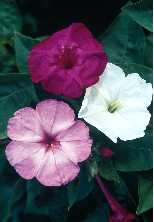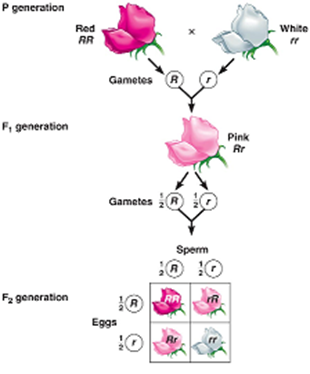Science > Biology > Genetic Basis of Inheritance > Dominance and Codominance
Mendel performed his experiments with garden pea plant, which has traits or alleles having complete dominance and hence the laws of inheritance were proved. Other scientists performed their experiments on different plants and animals and found deviations to Mendelian ratios. Depending upon these experiments and observations, a different pattern of inheritance called gene interactions was discovered. This study is known as Post – Mendelian genetics or Neo-Mendelian genetics. In this article we shall study the concept of complete dominance, partial dominance, and codominance.
Gene Interactions:
It was observed that the phenotypic expression of a gene can be modified or influenced by the other gene. This phenomenon is called gene interaction. There are two types of gene interactions
Intragenic (Interallelic) Interaction:
It occurs between alleles of the same gene e.g. incomplete dominance, co-dominance, and multiple alleles.
Intergenic (nonallelic) Interaction:
It occurs between the alleles of different genes on the same or different chromosomes. e.g. Pleiotropy, polygeny, epistasis, supplementary and complementary genes.
Neo-mendelian genetics includes interaction between alleles of a gene (interallelic interaction or intragenic interaction) and intergenic interaction or multiple genes inheritance.
Incomplete Dominance or Partial Dominance Or Blending Dominance:

In this case, both the genes of an allelomorphic pair express themselves partially. One gene cannot suppress the expression of other completely. e.g. four o’clock plant, snapdragon (Dog flower or Antirrhinum)
When a cross is made between true-breeding red-flowered plants (RR) and true breeding white-flowered plants (rr), the F1 generation is all pink-flowered (Rr) plants.
When pink-flowered plants of F1 generations are self-pollinated i.e. crossed among themselves, the F2 plants with red (RR), pink (Rr) and white (rr) flowers appear in the ratio 1:2:1. Here the phenotype ratio matches the genotype ratio of a monohybrid cross, but the phenotype ratio had changed from Mendelian ratio 3:1. No allele is dominant but the expression is intermediate between the two.

e.g. Andalusian Fowls (Chickens):

Andalusian fowls occur in three colours: black, white and blue. A cross between pure black (BB) and pure white (bb) produces F1 blue hybrid fowls. The genotype ratio of F1 generation is pure black (BB) : hybrid blue (bb) : Pure white (bb) is 1:2:1.
The phenomenon of incomplete dominance can be explained on the basis of Mendelian segregation. In complete dominance, the recessive factor cannot express, but in incomplete dominance both alleles have equal chance to express, hence we get hybrid intermediate in the F1 generation.
Characteristics of Incomplete Dominance:
- In this case, both the genes of an allelomorphic pair express themselves partially.
- The expression of the hybrid genotype is intermediate to the phenotypes produced by each of the alleles separately.
- One gene can not suppress the expression of others completely.
- The expressed phenotype is new and no allele has its own effect.
- It is the result of the quantitative effect of alleles.
- The mixing of the phenotype effect of alleles is found.
Co-dominance:
In this case, both the genes of an allelomorphic pair express themselves equally in the F1 generation. Such alleles express themselves independently even if present together in hybrids are called co-dominant alleles e.g. coat colour of cattle.
When red cattle are crossed with white cattle, the F1 generation has a roan coat colour where black and white patches appear separately. When F1generation is self-crossed, F2 Generation shows 4 phenotypes with ratio White: Both white and red: red = 1:2:1 and Genotypic ratio WW:RW: RR = 1:2:1. In F2 generation the phenotype ratio matches the genotype ratio.


Characteristics of Codominance:
- In this case, both the genes of an allelomorphic pair express themselves equally in the F1 generation.
- Both the alleles express equally.
- The expressed phenotype is the combination of two phenotypes of the two alleles.
- No quantitative effect of alleles is found.
- No mixing of phenotype effect of alleles is found.
Complementary Genes:
In this type of interaction, two separate pairs of genes interact to produce the phenotype in such a way that neither dominant is expressive unless another one is present. Thus the effect of one dominant is expressed if and only if another dominant complement it. These types of genes are called complementary genes. This inheritance was discovered by W. Bateson and R. C. Punnett in sweet pea (Lathyrus odoratus).
When two certain white-flowered varieties of sweet pea are crossed with each other. They produced the F1 plant with red flowers. The F2 generation is obtained by self-pollination of the F1 generation, The ratio of red-flowered plants to white-flowered plants is found to be 9:7, which was different than the dihybrid ratio of 9:3:3:1.
The red colour in the flower of a sweet pea plant is produced by a pigment called anthocyanin. Its formation depends on two independent factors (C and P). Both these factors must be present to produce the pigment.

Multiple Alleles:
More than two alternative forms (alleles) of a gene in a population occupying the same locus on a chromosome or its homologue are known as multiple alleles. Thus the multiple alleles are multiple alternatives of the same gene which influence the same character and produce different expressions in different individuals of a species or population.
e.g. In Drosophila, a large number of multiple alleles are known. One of them is the series of wing abnormally ranging in size from normal wings to no wings.

Characteristics of Multiple Alleles:
- Multiple alleles arise by mutation of the wild type of gene.
- They occupy the same locus on homologous chromosomes.
- They regulate the same character but have a different degree of expression.
- They do not undergo crossing over.
- Only one member of the series of multiple alleles is present in a given chromosome and only two members in an individual.
- In multiple alleles, the wild type of expression is dominant while all other expressions are recessive to the wild type. But there may be complete dominance or codominance.
Blood Groups in Human Beings:
The gene I control ABO blood groups it has three alleles; IA, IB and i. The allele IA and IB produce slightly different types of sugar and allele i does not produce any sugar. The letter I is derived from the word Isoagglutinin (antigen)
As humans are diploid organisms, each person possesses any two of the three I genes. IA and IB are co-dominant and completely dominant on i.

Blood Group of Progeny (Children):
